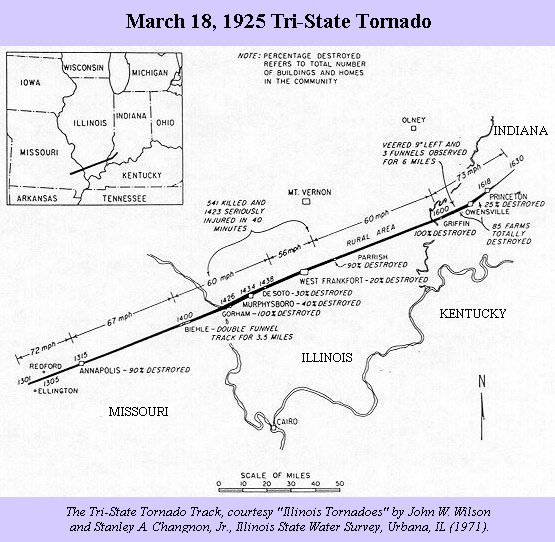


The month of March 1925 was the deadliest month of tornadoes in U.S. history. Likewise, 1925 also goes down in history as the year with the most fatalities caused by tornadoes in this country.* Suprisingly, the vast majority of these fatalities (695 in total) came from one single, long-track tornado. The Tri-State Tornado carved a 219+ mile path of destruction through southeast MO, southern IL, and southwest IN.
A surface low pressure system moved northeastward out of OK, reaching southern MO by the morning of March 18, 1925. Out ahead of this area of low pressure, warm and relatively moist air surged northward, with highs reaching the upper 60s to low 70s across southern MO and southern IL. Along with the wind shear (turning winds with height) afforded by the approaching low pressure center, numerous rotating supercell storms formed, spawning not only the devastating Tri-State Tornado, but 8 other tornadoes across the Mid-Mississippi and Ohio Valleys that same day.

The Tri-State Tornado itself formed shortly after 1pm near Ellington, MO. The tornado already killed at least 11 people before continuing to speed northeastward across the Mississippi River into southern IL. In the town of Murphysboro, IL alone, 234 deaths occurred, the most in any single community by a tornado since U.S. records have been kept. The tornado continued across the remainder of southern IL, and into southwest IN, before finally dissipating around 4:30pm. In its wake, 695 people lost their lives, 2,000 were injured, and a damage path 219 miles long was carved across the Midwest (all record-breaking figures for any single U.S. tornado).
Although death tolls from tornadoes were generally higher in the first half of the 20th century before tornado forecasting and warning systems began to be developed, the Tri-State tornado had several unique characteristics which some have proposed contributed to the enormous loss of life. The first of these attributes is the tornado's record breaking forward speed, approaching 70+ mph along portions of its track. This forward speed, even with modern warning systems, would have decreased the time available for people to seek shelter. Second, was the low visibility of the tornado itself. Many first-hand accounts from tornado survivors reported that no funnel was visible for much of the tornado's duration, possibly due to rain or other heavy precipitation obscuring the tornado from view. Third, was the sheer strength of the winds in the tornado itself. By examining damage reports as well as photographs taken in 1925, most modern-day experts agree the tornado was most likely an F/EF 5, or a tornado with winds greater than 200 mph. As was seen just a couple of years ago in the devastation of Joplin, MO, even with modern-day Doppler radar and a multitude of media outlets for quick warning dissemination, 100+ deaths from a single tornado are still possible if a strong tornado hits a densely populated area.
For an insightful video, including interviews of survivors of the Tri-State Tornado, check out this link: http://www.youtube.com/watch?v=M3dbojUnl5I
More information is also available from the NWS Paducah, KY.
*Estimates of fatalities in the February 1884 "Enigma Outbreak" vary widely from 178 to as much as 1,200 (due to the lack of systematic weather statistics)